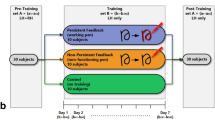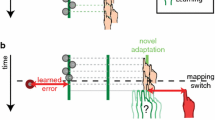Abstract
We investigated the role of visual feedback of task performance in visuomotor adaptation. Participants produced novel two degrees of freedom movements (elbow flexion–extension, forearm pronation–supination) to move a cursor towards visual targets. Following trials with no rotation, participants were exposed to a 60° visuomotor rotation, before returning to the non-rotated condition. A colour cue on each trial permitted identification of the rotated/non-rotated contexts. Participants could not see their arm but received continuous and concurrent visual feedback (CF) of a cursor representing limb position or post-trial visual feedback (PF) representing the movement trajectory. Separate groups of participants who received CF were instructed that online modifications of their movements either were, or were not, permissible as a means of improving performance. Feedforward-mediated performance improvements occurred for both CF and PF groups in the rotated environment. Furthermore, for CF participants this adaptation occurred regardless of whether feedback modifications of motor commands were permissible. Upon re-exposure to the non-rotated environment participants in the CF, but not PF, groups exhibited post-training aftereffects, manifested as greater angular deviations from a straight initial trajectory, with respect to the pre-rotation trials. Accordingly, the nature of the performance improvements that occurred was dependent upon the timing of the visual feedback of task performance. Continuous visual feedback of task performance during task execution appears critical in realising automatic visuomotor adaptation through a recalibration of the visuomotor mapping that transforms visual inputs into appropriate motor commands.







Similar content being viewed by others
Notes
This torque was determined for each participant on an individual basis to account for differences in the weight and length of participants’ arms.
As a precaution to help prevent this scenario, the servo-motors controlling movement in each degree of freedom were programmed with elastic ‘walls’ at the limits of the visual display, i.e., very large torques were required to move beyond a 60° rotation from the start position. If the manipulandum approached these limits, participants would feel a strong spring-like force that repelled them away from region corresponding to the edge of the visual display. We note, however, that no participants hit the ‘walls’ within the experimental trials.
References
Bernier PM, Chua R, Franks IM, Khan MA (2006) Determinants of offline processing of visual information for the control of reaching movements. J Mot Behav 38:331–338
Bernier PM, Chua R, Inglis JT, Franks IM (2007) Sensorimotor adaptation in response to proprioceptive bias. Exp Brain Res 177:147–156
Binsted G, Brownell K, Vorontsova Z, Heath M, Saucier D (2007) Visuomotor system uses target features unavailable to conscious awareness. Proc Natl Acad Sci USA 104:12669–12672
Burke D, Hagbarth KE, Lofstedt L (1978) Muscle-spindle responses in man to changes in load during accurate position maintenance. J Physiol Lond 276:159–164
Caithness G, Osu R, Bays P, Chase H, Klassen J, Kawato M, Wolpert DM, Flanagan JR (2004) Failure to consolidate the consolidation theory of learning for sensorimotor adaptation tasks. J Neurosci 24:8662–8671
Cohen J (1969) Statistical power analysis for the behavioral sciences. Academic Press, New York
Cunningham HA (1989) Aiming error under transformed spatial mappings suggests a structure for visual motor maps. J Exp Psychol Human Percept Perform 15:493–506
Ernst MO, Banks MS (2002) Humans integrate visual and haptic information in a statistically optimal fashion. Nature 415:429–433
Flanagan JR, Rao AK (1995) Trajectory adaptation to a nonlinear visuomotor transformation—evidence of motion planning in visually perceived space. J Neurophysiol 74:2174–2178
Franklin DW, So U, Burdett E, Kawato M (2008) Visual feedback is not necessary for the learning of novel dynamics. PLoS One 12:e1336
Ghahramani Z, Wolpert DM (1997) Modular decomposition in visuomotor learning. Nature 386:392–395
Ghez C, Gordon J, Ghilardi MF (1995) Impairments of reaching movements in patients without proprioception. 2. Effects of visual information on accuracy. J Neurophysiol 73:361–372
Hinder MR, Walk L, Riek S, Carson RG (2007) The interference effects of non-rotated versus counter-rotated trials in visuomotor adaptation. Exp Brain Res 180:629–640
Hinder MR, Tresilian JR, Riek S, Carson RG (2008) The contribution of visual feedback to visuomotor adaptation: How much and when? Brain Res 1197:123–134
Houk JC, Rymer WZ, Crago PE (1981) Dependence of dynamic-response of spindle receptors on muscle length and velocity. J Neurophysiol 46:143–166
Kawato M (1999) Internal models for motor control and trajectory planning. Curr Opin Neurobiol 9:718–727
Keppel G (1982) Design and analysis: a researcher's handbook, 2nd edn, Prentice Hill, New Jersy
Klapp ST (1995) Motor response programming during simple and choice-reaction time—the role of practice. J Exp Psychol Human Percept Perform 21:1015–1027
Klassen J, Tong C, Flanagan J (2005) Learning and recall of incremental kinematic and dynamic sensorimotor transformations. Exp Brain Res 164:250–259
Krakauer JW, Ghilardi MF, Ghez C (1999) Independent learning of internal models for kinematic and dynamic control of reaching. Nat Neurosci 2:1026–1031
Krakauer JW, Pine ZM, Ghilardi M-F, Ghez C (2000) Learning of visuomotor transformations for vectorial planning of reaching trajectories. J Neurosci 20(23):8916–8924
Krakauer JW, Ghez C, Ghilardi M-F (2005) Adaptation to visuomotor transformations: consolidation, interference, and forgetting. J Neurosci 25:473–478
Lackner JR (1974) Adaptation to displaced vision—role of proprioception. Percept Mot Skills 38:1251–1256
Lackner JR, Dizio P (1994) Rapid adaptation to coriolis-force perturbations of arm trajectory. J Neurophysiol 72:299–313
Mazzoni P, Krakauer JW (2006) An implicit plan overrides an explicit strategy during visuomotor adaptation. J Neurosci 26:3642–3645
McNay EC, Willingham DB (1998) Deficit in learning of a motor skill requiring strategy, but not of perceptuomotor recalibration, with aging. Learn Mem 4:411–420
Miall RC, Jenkinson N, Kulkarni K (2004) Adaptation to rotated visual feedback: a re-examination of motor interference. Exp Brain Res 154:201–210
Newell A, Rosenbloom PS (1981) Mechanisms of skill acquisition and the law of practice. In: Anderson JR (ed) Cognitive skills and their acquisition. Lawrence Erlbaum, Hillsdale, New Jersey
Pisella L, Grea H, Tilikete C, Vighetto A, Desmurget M, Rode G, Boisson D, Rossetti Y (2000) An ‘automatic pilot’ for the hand in human posterior parietal cortex: toward reinterpreting optic ataxia. Nat Neurosci 3:729–736
Rymer WZ, Dalmeida A (1980) Joint position sense—the effects of muscle-contraction. Brain 103:1–22
Scheidt RA, Conditt MA, Secco EL, Mussa-Ivaldi FA (2005) Interaction of visual and proprioceptive feedback during adaptation of human reaching movements. J Neurophysiol 93:3200–3213
Shadmehr R, Mussa-Ivaldi FA (1994) Adaptive representation of dynamics during learning of a motor task. J Neurosci 14:3208–3224
Shemmell J, Tresilian JR, Riek S, Barry BK, Carson RG (2005) Neuromuscular adaptation during skill acquisition on a two degree-of-freedom target-acquisition task: dynamic movement. J Neurophysiol 94:3058–3068
Teasdale N, Bard C, Fleury M, Young DE, Proteau L (1993) Determining movement onsets from temporal series. J Mot Behav 25:97–106
Tong C, Wolpert DM, Flanagan JR (2002) Kinematics and dynamics are not represented independently in motor working memory: evidence from an interference study. J Neurosci 22:1108–1113
Tseng YW, Diedrichsen J, Krakauer JW, Shadmehr R, Bastian AJ (2007) Sensory prediction errors drive cerebellum-dependent adaptation of reaching. J Neurophysiol 98:54–62
van Beers RJ, Sittig AC, van der Gon JJD (1999) Integration of proprioceptive and visual position-information: an experimentally supported model. J Neurophysiol 81:1355–1364
van Beers RJ, Wolpert DM, Haggard P (2002) When feeling is more important than seeing in sensorimotor adaptation. Curr Biol 12:834–837
Wang J, Sainburg RL (2004) Limitations in interlimb transfer of visuomotor rotations. Exp Brain Res 155:1–8
Wigmore V, Tong C, Flanagan JR (2002) Visuomotor rotations of varying size and direction compete for a single internal model in motor working memory. J Exp Psychol Human Percept Perform 28:447–457
Wolpert DM, Ghahramani Z, Jordan MI (1995) Are arm trajectories planned in kinematic or dynamic coordinates—an adaptation study. Exp Brain Res 103:460–470
Author information
Authors and Affiliations
Corresponding author
Rights and permissions
About this article
Cite this article
Hinder, M.R., Riek, S., Tresilian, J.R. et al. Real-time error detection but not error correction drives automatic visuomotor adaptation. Exp Brain Res 201, 191–207 (2010). https://doi.org/10.1007/s00221-009-2025-9
Received:
Accepted:
Published:
Issue Date:
DOI: https://doi.org/10.1007/s00221-009-2025-9




